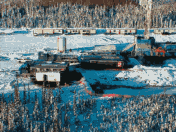International
Canadian vendors strive to keep their industry competitiveUpstream professionals in West Texas may think they control the market on pessimism in today’s depressed industry, but a recent visit to Calgary by your faithful editor suggests that they have competition in Canada. No, people are not jumping out of 20th floor windows, but the composite Canadian outlook is very bearish. World Oil’s forecast calls for 9,950 Canadian wells this year, yet some folks at Calgary-based companies were predicting as few as 5,600 or 6,000 wells. These people were hit hard last year, and oil price activity during early 1999 has not given them any hope that there is light at the end of the tunnel. Nevertheless, some equipment/service firms in Calgary continue to look for innovative solutions and new technical twists that will make their oil company clients’ operations more cost-efficient. Two good examples are Tesco Corp.’s Reservoir Drilling Services Division (RDS) and the entrepreneurial Crown Industries.
Integrated underbalanced drilling system. At RDS, there has been an effort to research and develop underbalanced drilling techniques, with an eye toward reducing operators’ drilling and production costs. "We are driven by turning academic concepts into practical applications," said Jim Walker, the company’s sales manager. "We acknowledge that underbalanced drilling, per se, is not an emerging concept in Canada. However, in many areas, it has not been tried, due either to regulatory hurdles, unfavorable logistics and/or local economics. Furthermore, the technology is continually evolving, and this is where we excel." Not content to be "just a service provider," RDS became an equipment builder, too. The firm manufactures its own process control equipment, including a push/pull snubbing system and a double, annular flow diverter, plus top drives and hydraulic rigs. The company also assembles its own nitrogen compression system. It should surprise no one, then, that the marriage of services and equipment enables RDS to produce its ultimate offering, an integrated underbalanced drilling (IUBD) system. When Walker and colleagues speak of an IUBD system, they are referring to a package that includes planning and engineering; compression and inert gas generation; high-pressure liquid pumping; flow pressure separation; data acquisition; and control systems. It is a system that can perform underbalanced drilling with a standard rotary rig and jointed pipe, or with a coiled tubing unit. The company’s ability to produce nitrogen gas on-site contributes greatly to overall cost savings generated by the integrated package, because the requirement for a separate injection contractor is eliminated. Use of the IUBD system in a single-supplier scheme also results in condensed field operations, i.e., fewer on-site personnel. That translates into savings in salaries, travel and support services, and more efficient management practices. In addition, RDS uses newly designed and manufactured equipment in the package, reducing downtime for maintenance and repairs. Sometime this year, RDS expects to have eight IUBD systems working. In addition to Canadian customers, the firm is providing services in Mexico, and additional projects are likely in Iran, Algeria, the North Sea and others. RDS also has a formal joint operating agreement with Schlumberger for use of the latter’s coiled tubing units. New or retrofitted equipment. Crown Industries is a privately held fledgling firm that has grown quickly to become sought-after for full-service, oil field equipment manufacturing. What stands out is Crown’s ability to design, engineer, manufacture and finish any piece of heavy equipment, and do it all under one roof. In June 1998, Crown opened a new, purpose-built facility in southeastern Calgary. It houses premier equipment for welding, manufacturing, retrofitting, engine rebuilding, sandblasting, painting and testing. The 100,000-sq-ft shop signifies the company’s belief that 1997’s record Canadian drilling activity was not a fluke. It also represents the firm’s determination to ride out the tough year ahead. "A lot of oil companies want to be ready when the good times roll around again, and we’re going to be ready for them," said Crown Vice President Todd Fisher. "That means either building brand new equipment using the latest advances or retrofitting existing pieces to make them operate like new." A recent plant tour showed that the company is particularly good at constructing or
retrofitting a variety of oil field service trucks, drilling rigs and truck-mounted workover
rigs. Among these, two trucks were destined for China, where E&P activity remains at a
high level. Faced with lean budgets, oil companies say they like working with a manufacturer
like Crown that doesn’t rely on outsourcing, which translates into significant time and
cost savings. The company boasts shorter delivery times and an ability to retrofit older
units for 70% of the cost of buying new. It also is in the final stages of receiving API
certification. Copyright © 1999 World
Oil |
- Applying ultra-deep LWD resistivity technology successfully in a SAGD operation (May 2019)
- Adoption of wireless intelligent completions advances (May 2019)
- Majors double down as takeaway crunch eases (April 2019)
- What’s new in well logging and formation evaluation (April 2019)
- Qualification of a 20,000-psi subsea BOP: A collaborative approach (February 2019)
- ConocoPhillips’ Greg Leveille sees rapid trajectory of technical advancement continuing (February 2019)




